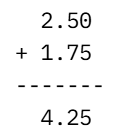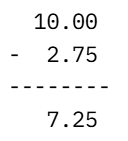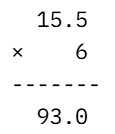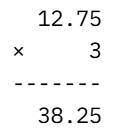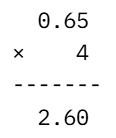Fractions and Decimals | Math Olympiad for Class 5 PDF Download
Q1. Ravi buys 2.5 kg of apples and 1.75 kg of oranges. How many kilograms of fruit does he buy in total?
(a) 4.25 kg
(b) 4.5 kg
(c) 3.75 kg
(d) 4.75 kg
Ans: (a) 4.25 kg
To find the total weight, add the decimals: 2.5 kg + 1.75 kg. Convert to like decimals: 2.50 + 1.75. Line up the decimal points:
So, Ravi buys 4.25 kg of fruit, a common shopping calculation.
Q2. Neha has 3/4 of a pizza, and her brother eats 1/2 of it. How much pizza is left?
(a) 1/4
(b) 1/2
(c) 3/8
(d) 1/8
Ans: (a) 3/8
Neha starts with 3/4 of a pizza.
Her brother eats 1/2 of it: (1/2) × (3/4) = 3/8 (multiply numerators and denominators).
Subtract the eaten part: 3/4 - 3/8.
LCM of 4 and 8 is 8, so 3/4 = 6/8.
Then, 6/8 - 3/8 = 3/8.
Therefore, 3/8 of the pizza remains.
Q3. Pinky walks 3/5 km to school and 1/5 km back home. What is the total distance she walks?
(a) 4/5 km
(b) 2/5km
(c) 5/2 km
(d) 2/3 km
Ans: (a) 4/5 km
Q4. A tank holds 10 liters of water. If 2.75 liters is used, how much water remains?
(a) 7.25 liters
(b) 7.5 liters
(c) 6.75 liters
(d) 8.25 liters
Ans: (a) 7.25 liters
Subtract: 10 - 2.75. Write 10 as 10.00:
7.25 liters remain, an everyday water usage calculation.
Q5. Sita spends 2/5 of her pocket money on snacks and 1/10 on a toy. What fraction of her money has she spent?
(a) 1/2
(b) 3/10
(c) 1/5
(d) 1/3
Ans: (a) 1/2
Find a common denominator (same bottom number) for the fractions.
2/5 can be written as 4/10 (because and ).
1/10 stays the same.
Now, add the fractions:
Snacks (4/10) + Toy (1/10) = 5/10
Simplify the answer:
5/10 can be reduced to 1/2 (since both 5 and 10 can be divided by 5).
Q6. A shop sells cloth at 15.5 meters per roll. If 6 rolls are sold, how many meters of cloth are sold?
(a) 93 meters
(b) 90 meters
(c) 92 meters
(d) 95 meters
Ans: (a) 93 meters
Multiply: 15.5 × 6.
93 meters are sold (1 decimal place).
Q7. A garden path is 7/12 meters long. Another path is 5/6 meters long. Which path is longer, and by how much?
(a) 5/6, by 1/4 meter
(b) 7/12, by 1/6 meter
(c) 5/6, by 1/6 meter
(d) 7/12, by 1/4 meter
Ans: (c) 5/6, by 1/6 meter
Compare 7/12 and 5/6.
LCM of 12 and 6 is 12.
Convert: 5/6 = 10/12.
Then, 10/12 > 7/12.
Subtract: 10/12 - 7/12 = 3/12 = 1/6.
The 5/6 path is longer by 1/6 meter, a garden task.
Q8. A packet of biscuits costs 12.75 rupees. If you buy 3 packets, how much do you pay?
(a) 38.25 rupees
(b) 36.75 rupees
(c) 39.25 rupees
(d) 37.25 rupees
Ans: (a) 38.25 rupees
Multiply: 12.75 × 3.
You pay 38.25 rupees (2 decimal places).
Q9. A tailor uses 0.65 meters of cloth per shirt. How much cloth is needed for 4 shirts?
(a) 2.6 meters
(b) 2.4 meters
(c) 2.8 meters
(d) 2.2 meters
Ans: (a) 2.6 meters
Multiply: 0.65 × 4.
2.6 meters are needed (2 decimal places).
Q10. A recipe needs 1½ cups of flour and ¾ cup of sugar. How much more flour than sugar is needed?
(a) ¾ cup
(b) ½ cup
(c) 1 cup
(d) ⅔ cup
Ans: (a) ¾ cup
Understand the Mixed Fraction (1½ cups of flour):
1½ is a mixed fraction (whole number + fraction).
Convert it to an improper fraction for easy calculation:
1½ = 1 + ½ = 2/2 + ½ = 3/2 cups (since 1 whole = 2/2).
We need to solve:
3/2 (flour) – ¾ (sugar) = ?
Denominators: 2 and 4.
LCM of 2 and 4 = 4 (smallest number both can divide into).
3/2 becomes 6/4 (Multiply numerator and denominator by 2: 3×2 / 2×2 = 6/4).
¾ stays ¾ (already has denominator 4).
6/4 – ¾ = (6 – 3)/4 = ¾.
The recipe needs ¾ cup more flour than sugar.
|
37 videos|109 docs|51 tests
|
FAQs on Fractions and Decimals - Math Olympiad for Class 5
| 1. What are fractions and how are they represented? |  |
| 2. How do you convert a fraction to a decimal? |  |
| 3. What is the difference between proper and improper fractions? |  |
| 4. How can you add or subtract fractions? |  |
| 5. Why is it important to learn about fractions and decimals in Class 5? |  |

